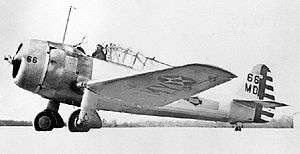Fleetwings BT-12 Sophomore
The Fleetwings BT-12 Sophomore, also known by the company designation Model 23, was a 1940s all-metal basic training monoplane built by Fleetwings for the United States Army Air Forces. Only 24 production examples of the type were built before the contract was cancelled.
| BT-12 Sophomore | |
|---|---|
 | |
| The XBT-12 | |
| Role | Basic trainer |
| National origin | United States |
| Manufacturer | Fleetwings |
| First flight | 1939 |
| Primary user | United States Army Air Forces |
| Produced | 1942-1943 |
| Number built | 25 |
Design and development
With the outbreak of the Second World War, the United States Army Air Corps (later U.S. Army Air Forces) was ill-prepared for a major war. In an effort to obtain as many aircraft as possible the USAAF contracted Fleetwings, a specialist fabricator of sheet stainless steel,[1] to produce a basic training monoplane. A prototype Model 23 was ordered as the XBT-12 during 1939.[2]
The XBT-12 was an all-metal low-wing cantilever monoplane with a fixed tailwheel landing gear and powered by a Pratt & Whitney R-985 engine. The aircraft had two identical tandem cockpits for instructor and pupil covered by a continuous canopy. It was the first military aircraft to be constructed primarily from welded stainless steel.[3]
Operational history
After evaluation of the XBT-12 starting in late 1939,[4] an order for 176 production aircraft, designated BT-12, was placed.[5] Only 24 aircraft were delivered, one in 1942 and 23 in 1943,[6] before the contract was cancelled,[2] the Vultee BT-13 being preferred.[1]
Variants
- XBT-12
- Army designation for the prototype Model 23, one built.
- BT-12
- Army designation for the production Model 23, 24 built, 152 cancelled.
Operators
Specifications (BT-12)
Data from The Illustrated Encyclopedia of Aircraft (Part Work 1982-1985), 1985, Orbis Publishing; also [4]
General characteristics
- Crew: Two (pilot and instructor)
- Length: 29 ft 2 in (8.89 m)
- Wingspan: 40 ft (12 m)
- Height: 11 ft 4 in (3.45 m)
- Wing area: 240.4 sq ft (22.33 m2)
- Empty weight: 3,173 lb (1,439 kg)
- Gross weight: 4,497 lb (2,040 kg)
- Powerplant: 1 × Pratt & Whitney R-985-AN-1 Wasp Junior radial engine, 450 hp (340 kW)
Performance
- Maximum speed: 195 mph (314 km/h, 169 kn)
- Cruise speed: 150 mph (240 km/h, 130 kn)
- Range: 675 mi (1,086 km, 587 nmi)
- Service ceiling: 23,800 ft (7,300 m)
- Time to altitude: 10 minutes to 10,000 feet
See also
Aircraft of comparable role, configuration and era
Related lists
References
| Wikimedia Commons has media related to Fleetwings BT-12 Sophomore. |
- Notes
- Pattillo, Donald M. (2001). Pushing the Envelope: The American Aircraft Industry. Ann Arbor, MI: University of Michigan Press. p. 131. ISBN 978-0472086719.
- Gunston, Bill (1994). World Encyclopaedia of Aircraft Manufacturers. Annapolis, MD: Naval Institute Press. p. 118. ISBN 978-1557509390.
- Pitkin, Walter (1942). What's That Plane?: The Handbook for Practical Aircraft Identification (2nd ed.). New York: Penguin Books. p. 60. ASIN B001DEMTMO.
- Historical Office of the Army Air Forces (1947). The official pictorial history of the AAF. New York: Duell, Sloan and Pierce. p. 177. ASIN B000GU84Z2.
- Andrade, John (1979). U.S. Military Aircraft Designations and Serials since 1909. Leicester, UK: Midland Counties Publications. p. 61. ISBN 0-904597-22-9.
- Trimble, William F. (1982). High Frontier: A History of Aeronautics in Pennsylvania. Pittsburgh, PA: University of Pittsburgh Press. pp. 217–218. ISBN 0-8229-5340-4.
- Bibliography
- The Illustrated Encyclopedia of Aircraft (Part Work 1982-1985), 1985, Orbis Publishing
Further reading
- Baker, David (October 1943). "Design Analysis of the Fleetwings BT-12". Aviation. pp. 119–132, 356.